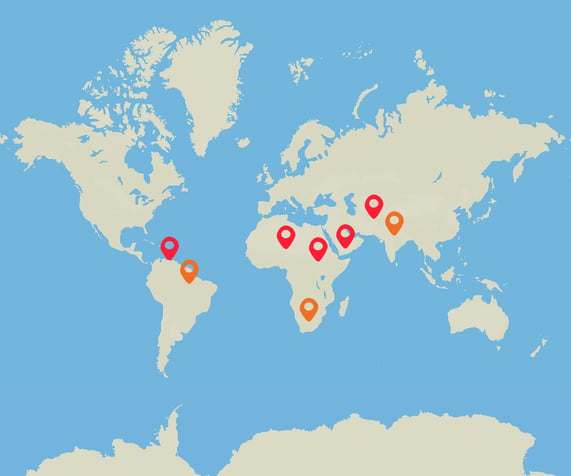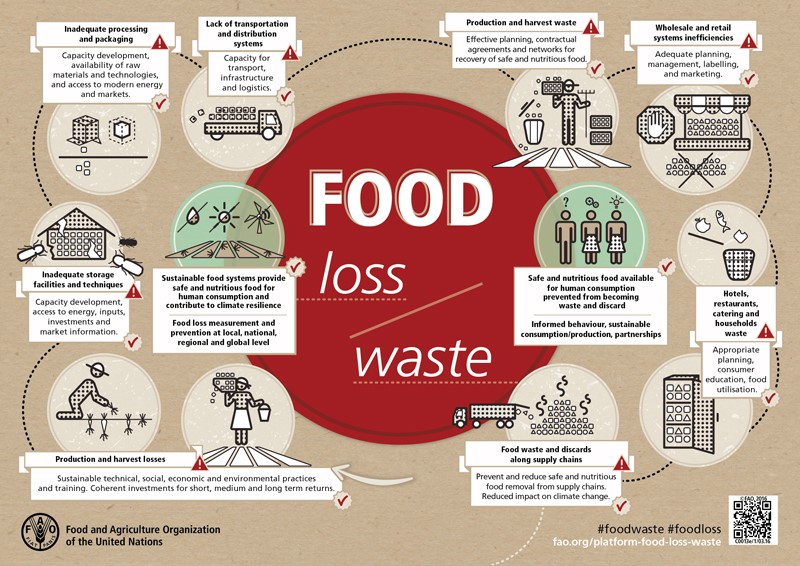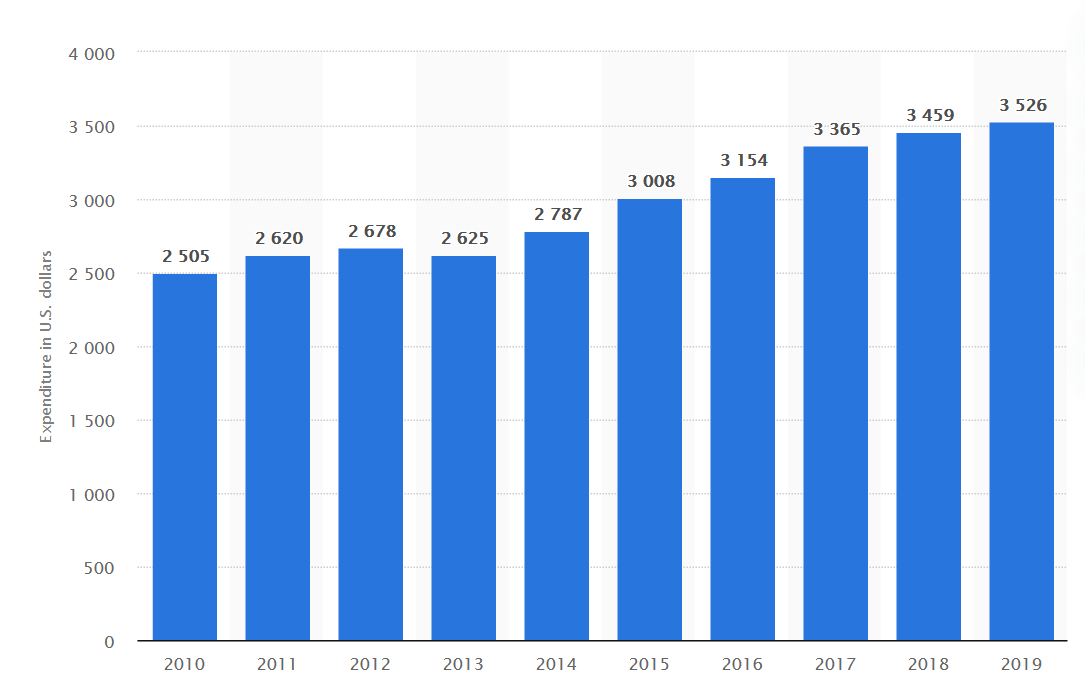An insight into what food waste really means and the processes that create it. Reducing food loss is a global, multidimensional challenge, so what can the foodservice industry specifically do to be more mindful of its role in the food value chain?
The current state of food wastage
On September 29, the world celebrated the 1st International Day of the Food Loss and Waste. This was a good opportunity to emphasize the importance of reducing food waste (FW) as a key sustainability challenge for the hospitality and foodservice industry. FW epitomizes an unsustainable system of food production and consumption. A recent report by the Boston Consulting Group (BCG) calculates that the amount of food wasted each year will rise by a third by 2030, “when 2.1 billion tons will either be lost or thrown away, equivalent to 66 tons per second”.
Food wastage appears to be higher in developed countries, while on the other hand, there are an estimated 842 million people in poor countries experiencing chronic hunger. According to Oxfam, the current pandemic has deepened the hunger crisis and “by the end of the year, 12,000 people per day could die from hunger linked to COVID-19, potentially more than will die from the disease itself”. Ten countries top the list of hunger spots (Figure) accounting for 65% people living in crisis level hunger.

Figure 1: Countries and regions where the food crisis is most severe (Oxfam, 2020)
According to the Food and Agriculture Organization of the United Nations (FAO), FW is defined as food which is fit for consumption but discarded by choice or because has been left to spoil or expire, with ‘food’ referring to “whether processed, semi-processed or raw edible products going to human consumption.”

Image Credits : Food loss/waste
The fact that FW is perceived as a mounting, yet avoidable, challenge has driven the United Nations to adopt target 12.3 as part of the 17 Sustainable Development Goals to:
By 2030, halve per capita global food waste at the retail and consumer levels and reduce food losses along production and supply chains, including post-harvest losses.

Source : The sustainable Development Goals Report 2020
The how and where of food wastage
Food loss and waste occur at each stage of the global food value chain, from agricultural production to final consumption. Food production is linked to land conversion and biodiversity loss, energy consumption and greenhouse gas emissions, water and pesticide use. At the post-harvest and processing stages, there is also waste in each step of the transport, storage, processing and distribution stages. At the end of the food value chain, final consumption (including commercial and household) accounts for as much as 40% of total food losses. Evidence shows that in developed countries, food is mainly wasted at the final consumer stage of the supply chain.
FW management has thus become a key priority, referring to all the activities related to avoiding, reducing or recycling waste throughout the production and consumption chain. This raises the question as to whether food wastage could also be reduced along the food supply chains.
The FW challenge in tourism and foodservice
Tourism, as a global foodservice industry, is implicated in food consumption and waste generation. Consumer foodservices include restaurants, fast food chains, cafés, cafeterias, canteens and dining halls, as well as event catering. This sector employs more people than any single other retail business, including 14 million in the USA and 8 million in Europe (Euromonitor International) and serves billions of meals every year. The Figure shows the average annual food away-from-home expenditure of U.S. households from 2010 to 2019. In 2019, average food away-from-home expenditure of U.S. households amounted to about 3,526 U.S. dollars, compared to 2,505 dollars in 2010. Therefore, the activity has a critical role in the global FW challenge.

Figure 2: Average annual food away-from-home expenditures of United States households from 2010 to 2019 (in U.S. dollars) (Source: Statista, 2020)
FW must be approached as a multidimensional challenge in which different stakeholders in the food value chain play a decisive role on integrating innovations aimed at FW minimization and management.
- Producers: Collaborating with local farmers, e.g. sourcing locally can boost FW source reduction and turn FW into animal feed.
- Suppliers: Partnering with suppliers that are ready to participate in sustainable initiatives (e.g. oil suppliers that collect used oil).
- Retailers: Bargaining an off-spec protocol that consider FW reduction, e.g. acquiring imperfect or off-grade produce before is thrown away.
- Employees: Providing with training for purchasing inventory management, production planning and menu planning & service.
- Consumers: Increasing awareness and engagement of customers (dining out) and households (dining in).
- Collaborative platforms: Partnering with food donation recovery partners, e.g. Too good to go.
- Technology providers: Data feeding restaurants with FW information, e.g. Kitro technology (article).
Study findings
Despite the significance of this issue to the global foodservice industry, the link between innovation practices and FW management has received limited attention. An exception is Martin-Rios et al. (article) recent research on the interrelationships of foodservice provisions and innovations in FW management through the lenses of innovation theory.
The study presents a range of waste management initiatives using the distinction between incremental innovations (those revolving around work processes and technologies) and radical innovations (innovations exploring opportunities to significantly change waste management approaches). The study also points out different approaches to FW based on FW characterization, management practices and management’s beliefs, knowledge and awareness to identify practices that suggest some type of innovation.

Table: Summary of FW innovations for the hospitality and commercial foodservice
The main objectives
The concepts discussed in this research could help practitioners to become more aware of the factors that drive the adoption of FW innovations. Any initiative towards FW minimization and management must necessarily address the following two objectives:
- Customization: Identify which innovative food management practices contribute to the avoidance (reducing and rethinking), re-use or recycling of food waste in each particular foodservice establishment.
- Awareness: Evaluate foodservice managers’ perspectives regarding the opportunities, challenges, costs and benefits of various FW innovations.
A traditional waste management program that ignores social aspects of management and professional skills can be a barrier to the effective implementation of FW innovations. Results also show that interest in innovation as a systematic process to minimize waste and facilitate waste management is limited.
Foodservice providers implement innovations based on a cost-saving analysis. Interviews highlighted a general lack of concern and knowledge about FW management. Food industry professionals face an array of daily organizational and financial challenges linked to waste sorting, storage and disposal, and they mostly count on the standard recycling/waste procedures their local councils make available to cope with them. Professionals tend to approach waste reduction from a practical, experience-based approach, but there is no systematic implementation of waste reduction strategies based on forms of institutional knowledge. What they really need is proper training and achievable goals to be set by governments.
A key finding is that many companies are not actively innovating in the waste domain. They are however increasingly aware of the economic and social importance of waste management. The foodservice industry is not leading the way when it comes to innovation. There are only a few low- or zero-waste restaurants, and just a few chefs who are creating meals out of food scraps.
Conclusion
One important finding academic research highlights is the importance of developing partnerships between foodservice providers and other businesses, non-for-profits, and institutional players. Closer collaboration underlines the importance of bringing together different (and sometimes competing) stakeholders, and combining between them innovation types and innovation generation and adoption with greater efficiency. This calls for more research, tools and concepts to design the innovative practices supporting the next generation of FW management systems if the situation is to ever improve.
Foodservice, as a labor-intensive activity where innovation has tended to be slow, can benefit from other firms and institutions sharing knowledge, insights and experiences, helping the industry get on track to hit the goal of halving food waste by 2030.
References
- Martin-Rios, C., Zizka, L., Varga, P., & Pasamar, S. (2020). KITRO: technology solutions to reduce food waste in Asia-Pacific hospitality and restaurants. Asia Pacific Journal of Tourism Research, 1-8.
- Martin-Rios, C., Demen-Meier, C., Gössling, S., & Cornuz, C. (2018). Food waste management innovations in the foodservice industry. Waste management, 79, 196-206.
- Martin-Rios, C., Gössling, S., Arboleya, J.C., Bolton, J. & Erhardt, N. (2020). Sustainable food waste management: Research Topic. Frontiers in Sustainable Food Systems. Available here





